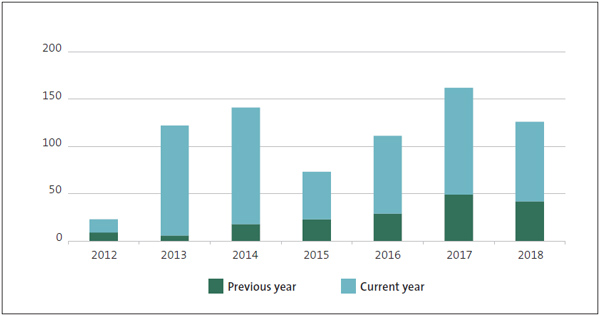Part 1: Completion of the 2017 school audits
1.1
Of the 2442 audits that we expected to complete for 2017 (which includes schools and school subsidiaries), we completed 2110 (86%) by the statutory deadline of 31 May 2018. This was an improvement on last year, where 81% of 2016 audits were completed by the statutory deadline. Some of the school audits missed the deadline because of the performance of a few school auditors. If those audits are excluded from the total, 90% of the school audits were completed by the statutory deadline.
1.2
The introduction of the Novopay system in August 2012 has contributed to poor timeliness of school audits in the past few years. For the 2017 school audits, we changed our approach to how we audited school payroll so schools had the information they needed to prepare their draft financial statements for audit earlier. The Ministry of Education (the Ministry) provided better and more timely guidance, which also helped. As a result, we have seen a general improvement in the quality of the draft financial statements that schools have provided for audit.
1.3
Although earlier reporting on payroll and better quality financial statements have resulted in an improvement in timeliness, we are still well below our target of having 95% of school audits completed before the statutory deadline.
1.4
By November, we usually expect less than 1% of the previous year's school audits to be outstanding. At 12 November 2018, 3% (84 audits) of the 2017 school audits were outstanding. Of these outstanding audits, 18 were delayed because we have been working with the auditors to resolve some quality concerns. If we exclude those audits, there would be 68 audits from 2017 outstanding – an improvement on the past few years (113 of the 2016 audits were outstanding at the same time last year). We are working with the auditors and the affected schools to complete these audits as soon as possible.
1.5
During the past few years, we have seen the number of outstanding audits from previous years increase. Figure 1 shows that, this year, the number of outstanding audits from previous years has reduced, contributing to a decrease in the total number of outstanding audits at 12 November 2018. Generally, once the statutory deadline passes, auditors face pressures resourcing the remaining audits because they have other work planned. Because the 2017 audits went more smoothly for auditors, they have had time to complete some of these outstanding audits from previous years.
1.6
Of the previous-year audits still outstanding, the oldest is a 2013 audit of a closed school. There are also three audits outstanding for 2014.
Figure 1
Outstanding audits as at 12 November for the years 2012 to 2018
The number of outstanding audits from previous years has reduced, contributing to a decrease in the total number of outstanding audits at 12 November 2018.

Source: Office of the Auditor-General.
1.7
Appendix 1 lists the individual audits that are outstanding as at 12 November 2018. The list shows that 20 of the 2017 audits outstanding are Kura Kaupapa Māori (kura), with 10 of these kura having audits from previous years outstanding. This represents a high proportion of the 73 kura.

